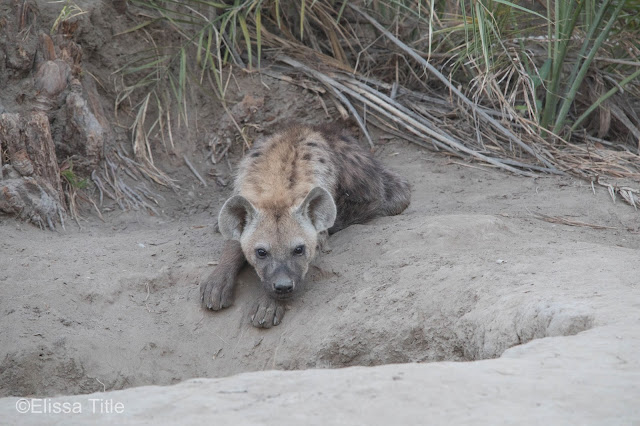MY MISSION is to travel the world to photograph endangered species and ecosystems that the average Joe wouldn't necessarily hear about. In this article, I feature some of my favorite destinations and animals that I've become incredibly passionate about. Raising awareness through visual storytelling and photography, it is my hope that I can spark change in others to create a happy, healthier Earth.
OKAVANGO DELTA, BOTSWANA. The landlocked country in Southern Africa has a landscape defined by the Kalahari Desert and the Okavango Delta which becomes lush during the seasonal floods. It is home to some of the world's most endangered species of large mammal, but the Okavango Delta is in desperate need of protection. The water originates in Angola to the north but with human development (water diversion, population density and commerce), less and less water actually reaches the Okavango Delta each year. Without the water, there are no animals. There will be no tourism. It will be a dry wasteland. If we can't find alternative methods that benefit locals and protect the Okavango Delta in the process, this amazing place will be reduced to nothing. However, in the midst of this trying time in the world of conservation, more and more camps are dedicated to reducing their environmental impact. One of my favorite camps in Africa, Duba Plains in Botswana, strives to reduce their environmental impact. Designed by Dereck Joubert, it is no surprise that about 70% of Duba Plains is powered by solar energy and all shampoos, conditioners, soaps, etc. are fully biodegradable and animal friendly. Duba Plains is a fully integrated community empowerment project with around 80% of the staff coming from nearby communities, which also motivates locals to participate in long-term conservation efforts.
 |
| Flying over the Okavango Delta. |
 |
| African bee-eater. |
MADAGASCAR is the fourth largest island, sometimes even called the Eighth Continent. This country has a high level of endemic species and naturalists find Madagascar as a laboratory of evolution, like the Galàpagos. Madagascar is one of the priority conservation areas, especially for primates (only Brazil has more biodiversity in primates than Madagascar). While Madagascar is one of the primary conservation areas, over 90% of the island has been deforested. While driving four hours from the capital city of Antananarivo to Andasibe National Park, I literally saw people chopping down trees on the side of the road. It broke my heart but the sad reality is that these streets are not nearly as patrolled as they should be so locals do whatever they want to make an income for their families with disregard to their surrounding environment. Human/wildlife conflict also occurs in Madagascar due to some parts of the local culture believing in superstitions. There are five families of lemurs... Mouse lemurs that are the smallest weighing at about 30 grams, indrids that are the largest of the lemurs and are specialized leapers weighing at about 20 pounds, sportive lemurs, true lemurs that are relatively well-studied because they're active during the day, and the aye-aye which is the most specialized primate about the size of a cat. Malagasy people actually believe that all humans are descended from lemurs, though that doesn't mean all lemurs are protected. One legend says that a man had two wives, but the wives fought a lot. One was turned into a ringtail lemur and the other was turned into a Sifaka lemur. Due to this story, locals believe it is a bad omen to harm these two species of lemurs. However some lemurs are killed due to bad superstitions, like the aye-aye. Locals believe that it is bad luck to have one point its finger at you, and aye-aye's are killed because of this.
 |
| Madagascar landscape on the way to Andasibe. |
 |
| Brown lemur aka true lemur. |
|
THE ARCTIC. Nature, at its most powerful, calls the shots in Greenland. It is the world’s biggest non-continental island that is more than 80% icecap. Unfortunately with global warming, that is rapidly changing. April 2016 brought worrisome news to climatologists... Greenland's annual melting season started two months early. By June, the thermometer had hit 75.5 degrees... the hottest temperature ever recorded for Greenland in June. New York City, which is further south, was roughly 5 degrees cooler on the same day. The Greenland Ice Sheet is about one quarter the size of the contiguous 48 US states and losing its entire ice sheet would add an estimated 23 feet to sea levels worldwide. This would drown New York City, London, Kolkata and almost all of the Bahamas. When I landed in Greenland to photograph polar bears, my first thought was "global warming". I kept repeating "where is the ice?" over and over again, day after day. Less sea ice means less foraging habitat for bears, and the bears become increasingly concentrated on the smaller patches of habitat. The concentration effect is critical for females with cubs since they are forced into proximity with males who act aggressively toward the young, or they are forced away from the remaining feeding habitat. With global warming, breakup of the sea ice happens earlier in the summer and refreezing occurs later so the length of time that bears are away from their favored foraging habitats increases.
 |
| A mother polar bear and her two cubs walk off into the distance. |
 |
| Polar bear looking at our approaching boat. |
ANTARCTICA is the largest desert in the world. It is also the coldest, windiest, highest and driest continent on Earth. The West Antarctic Peninsula is one of the fastest warming areas on Earth, with only some areas of the Arctic Circle experiencing faster rising temperatures. The Antarctic ice sheet contains sufficient ice to raise the world's sea level by more than 60 meters if melted completely. However, because Antarctica is so large, climate change is not yet having a uniform impact. In fact, some areas of the "White Continent" are actually experiencing increases in sea ice. Nonetheless, declining sea ice in other areas is quite problematic and is negatively affecting the wildlife populations. Krill feed on algae underneath sea ice but due to declining sea ice in some areas, populations have been declining around the West Antarctic Peninsula. As a result, Adélie penguin populations have been declining. Other species of penguins are forced to travel further distances to get food. Not all hope is lost for penguins just yet, though. A new study done by BBC revealed a super-colony of penguins spotted from space (see here:
http://www.bbc.com/news/science-environment-43250744).
 |
| Minke whale that popped up right at our zodiac. |
 |
| Adelie penguin in the Antarctic Peninsula. |
THE GALAPAGOS ISLANDS. When I went to the Galápagos for the first time in 2004, we were allowed to get much closer to the animals on the trails and we saw fewer people. In 2017, I headed back to the Galapagos as part of Chapman University's interterm Environmental Science course focusing on Darwin & the Galapagos. Just thirteen years later, I’ve noticed a huge difference in tourism to the islands. I saw many more boats, more tourists and many buildings, roads, and hostels being constructed. Since my first trip, tourism has increased partially due to the fact that the Galápagos is advertised as a place for nature and animal lovers who are interested in protecting the environment. However, with increasing numbers of tourists comes an even higher demand for hotels and tour companies resulting in more infrastructure. Every building and road that is constructed is land that’s being taken away from the animals in order to support heavy tourism in the area. More people walking on trails means the trails are more vulnerable to erosion and more tourist boats coming means more fuel in the ocean. The Galápagos Islands is so special due to the high biodiversity and ability to see animals up-close but as more tourists flock to the Galápagos, we are destroying the habitat that was once so natural. Travelers can visit the Galápagos at any time in the year as it’s not a seasonal location, which means the Galápagos receives many more tourists than seasonal travel destinations. Of the 20 endemic species that are critically endangered in the Galápagos, 16 live on the four inhabited islands that get the most visitors. If the Galápagos Islands are supposed to be highly regulated, why are we allowing so many people to visit each year?
 |
| Sally lightfoot crab on green algae. |
 |
| Tortoise at El Chato. |
LION CONSERVATION. Some predict lion populations will be extinct by 2020. This isn't just a tragedy to the species; it would also cause major ecological problems. Lions are already extinct in 7 African countries, and have lost more than 80% of their historic habitat. Lion populations are down to about 20,000 from 200,000 in 1970 and what is believed to be more than 500,000 in the 1940s. It is one of the fastest species declines known to man. Though lions occasionally come into villages and kill cattle, farmers kill the lions in retaliation instead of taking precautionary measures to protect their cattle. It's a never-ending cycle of human-wildlife conflict, and the lion populations suffer. So why don't we hear about it? I think we prioritize species to an extent. Elephants are viewed as more important than lions to those who know nothing of conservation, and I think this is in part due to local cultures portraying lions as vicious creatures. When I talk about lion conservation here in the United States, many people respond with "oh, I had no idea how endangered they are". In order to spark change, we need to create further awareness.
 |
| Male lion looking over at his pride. |
 |
| Lioness in the early morning light. |
ELEPHANT CONSERVATION. At the beginning of the 20th century there were a few million African elephants, but today there are around 450,000-700,000 African elephants, making them an endangered species. Every day, around 100 elephants are slaughtered for their tusks. The world’s largest consumer of ivory (accounting for some 70% of the total) is China and poaching has soared in recent decades due to this increase in demand. In 2011, over 23 tons of ivory was confiscated, which is equivalent to at least 2,500 elephants. With so few numbers of elephants left and such a slow rate of reproduction (one single calf is born to a female once every 4-5 years), this species is rapidly heading for extinction, unless united and global action is taken to save them.
 |
| Elephant portrait, Zimbabwe. |
 |
| Elephant in the Okavango Delta. |
In my mission and throughout my travels, I hope that I can inspire others to pursue their passions, take action, and get involved with issues facing the global community. Awareness starts with knowledge. This doesn't just affect one culture... It affects all of us and we need to work together to create a happier, healthier Earth.
Follow along with my upcoming travels for conservation photography (Svalbard Arctic, Botswana, Great Bear Rainforest, South Georgia & the Falklands, and Komodo Island). Stay tuned for what's to come and be sure to hit the subscribe button to be notified of new posts! As always, follow my instagram @elissatitle for more pics.
























Comments
Post a Comment